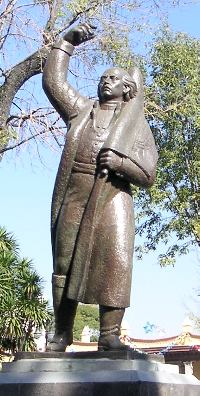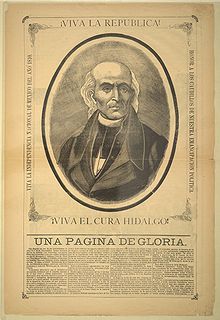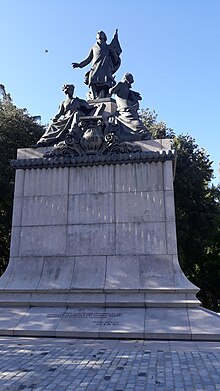Miguel Hidalgo

Miguel Gregorio Antonio Ignacio Hidalgo y Costilla y Gallaga Mondarte Villaseñor (born May 8, 1753 at the Hacienda de Corralejo near Pénjamo in the state of Guanajuato ; † July 30, 1811 in Chihuahua ) was a Mexican priest, scholar and is considered to be the Grito de Dolores , as the spiritual father of the insurrection that led to the Mexican War of Independence .
Life
Miguel Hidalgo was born on May 8, 1753, the second of four children of Creole Cristóbal Hidalgo and Ana María Gallaga. He spent his childhood on the San Diego Corralejo Estate. The first stroke of fate was the death of his mother in 1762 when he was barely eight years old. A few months later his father married Jerónima Ramos and the children from his first marriage moved to their maternal great-uncle, the pastor of Coenes. The great uncle took care of the children's education and in 1765, when he was 12 years old, sent Hidalgo to the College of San Nicolas in Valladolid , now Morelia . During his studies he dealt intensively with the revolutionary ideas of his famous teacher Francisco Javier Clavijero , author of the first history of Mexico and representative of the new national movement that was to play an important role in the liberation struggle.
In 1770 he completed his studies in the liberal arts and left the college, where he was nicknamed "Zorro" (Spanish for fox) because of his acuteness and knowledge. At the age of 20, he went to Mexico City in 1773 , where he graduated in philosophy and theology. In 1778 he was ordained a priest. In 1785 he returned to Valladolid and was appointed professor of theology and later rector of the university. A month after his appointment, he was accused by the Inquisition of heresy and had to resign from the rectorate and take up the post of parish priest in Colima , where he arrived on March 24, 1792.
At the same time, Hidalgo left his partner Manuela Ramos Pichardo, who had given him two children. In Colima he continued his studies and turned his interests to the events in America and Europe , where he dealt intensively with the ideas of the encyclopedists and the Freemasons .
In 1793 he took over the parish in San Felipe Torresmochas, where he stayed until 1800, when he was suspended as a result of the process that began in 1780. Hidalgo managed to get rid of the allegations through several trips to Mexico City.
In 1803, at the age of 50, he was appointed pastor of the affluent parish of Dolores . With the considerable income of 8,000 to 9,000 pesos annually, it was possible for him to transfer his duties in the parish to the priest Francisco Iglesias and to devote himself to his main interests, the study and economic development of the community. At his own expense he built workshops for pottery and tannery, introduced beekeeping and silkworms, planted vines for wine production and olive groves. He also founded an orchestra and a theater in which works by Molière and Racine that he had translated were performed. His frank criticism of the church led to his denunciation by his vicar, whereupon a new heretic trial was initiated, which was discontinued after a short time. His scientific knowledge made him the most famous scholar in all of Michoacán .
In 1806, on one of his trips to Mexico City, Hidalgo joined a lodge in the Freemasons. In 1808 he joined a secret society, the "Guadalupanos", which had set itself the goal of liberating Mexico from Spanish rule. The originators of this secret society were Ignacio Allende from San Miguel el Grande , Juan Aldama and Mariano Abasolo . Allende introduced Hidalgo to the ideas of the secret society during his visits to Dolores. However, while Allende supported the monarchy, Hidalgo showed strong sympathy for a republic modeled on the United States of America .
The plan of the secret society was to arrest all Spaniards in one day and set up a national government. If the plan failed, they would seek help from the United States or France. October 1, 1810 was set as the day of the uprising.
During an attempt on September 13 to recruit members of the Guanajuato garrison, the secret society's plan was revealed to the garrison commander. The conspirators were then to be arrested. However, when the corregidor of Querétaro, Miguel Domínguez , was informed of this project at the same time , his wife - the later national heroine of Mexico, Josefa Ortiz de Domínguez - managed to inform the mayor, who immediately rode to San Miguel to warn the conspirators .
At dawn on September 16, the conspirators decided they were starting a revolution . Hidalgo rang the church bells to call the parish to fight ( Grito de Dolores ) while Allende and Aldama went to the prison to free the prisoners. On the threshold of the Church of Dolores, Hidalgo called for a crusade against the Spanish occupiers and initially gathered around 600 people.
Within a few days he had taken the cities of Celaya and San Miguel El Grande without violence. In Guanajuato there was the first battle with troops loyal to the king entrenched in a granary ( Alhóndiga de Granaditas ), but they could be defeated. A month later he had also taken Guadalajara . On January 17, 1811, his army was defeated by Félix María Calleja del Rey in the battle of Puente de Calderón near Guadalajara, despite the large majority by the disciplined Spanish troops. Hidalgo was captured a little later, interrogated by the Spanish Inquisition , sentenced to death and executed . His head, along with those of Allende, Aldama and José Mariano Jiménez , was exhibited in a cage at a corner of the Alhóndiga de Granaditas for ten years.
Commemoration
Since 1824 September 16 - the day on which Hidalgo called for the crusade - has been a national holiday.
The Mexican state of Hidalgo , the city of Dolores Hidalgo , the football stadium Estadio Hidalgo des CF Pachuca and the asteroid 944 Hidalgo were named after Miguel Hidalgo y Costilla . Mexico minted currency coins with his portrait several times . It can also be seen on the front of the Mexico 1000 Peso banknote.
literature
- Juan, N. Chávarri: Historia de la guerra de independencia . Mexico 1961.
- Turner, Victor W [itter] , Hidalgo: history as social drama , in: ders., Dramas, Fields, and Metaphors. Symbolic action in human society , Ithaca 1974, 98-155.
Web links
| personal data | |
|---|---|
| SURNAME | Hidalgo, Miguel |
| ALTERNATIVE NAMES | Miguel Hidalgo y Costilla |
| BRIEF DESCRIPTION | Mexican priest and revolutionary |
| DATE OF BIRTH | May 8, 1753 |
| PLACE OF BIRTH | near Pénjamo in the state of Guanajuato |
| DATE OF DEATH | July 30, 1811 |
| Place of death | Chihuahua , Mexico |



